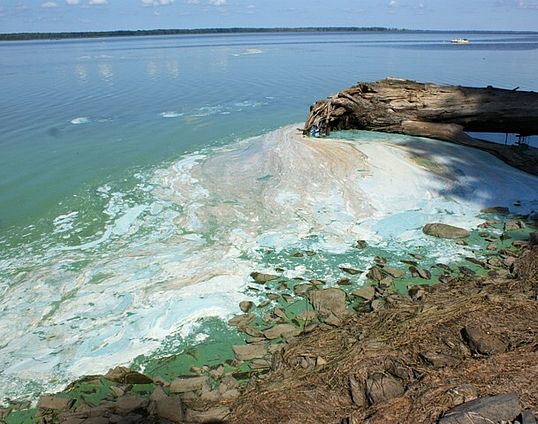Lake Champlain: How did we get where we are?
March 2016

Lake Champlain does not meet water quality standards. Every year, blue-green algae blooms plague northeastern bays and pop up in other places around the lake. Conditions have sparked outrage and led to new regulations on farms, municipalities, and developers. How did we get to the point that such regulations are necessary?
Algae blooms and high nutrient levels are signs of an aging lake. It is in the nature of all lakes to age, to gradually fill with sediment and become wetlands and finally just land. From a geologic perspective, lakes are just blips in the landscape.
Lake Champlain has already shrunk tremendously from its maximum extent. When the glaciers were just receding some 13,000 years ago, Lake Champlain (or rather its predecessor, Lake Vermont) filled much of the Champlain Basin. Towns as far inland as Jericho and East Middlebury would have been under water. Much of the land on which we live, work, farm, and play was under water.
Still, Lake Champlain is aging much more rapidly than it would without human pressures. Analysis of sediment cores shows there has been a greater than ten-fold increase in the rate of sediment accumulation since widespread European colonization in the 1700s.
Post-colonial land use changes have driven much of the increase. Forests were cleared for lumber, pasture, crops, and settlements. By the late 19th century nearly 70% of the region was devoid of trees. In the absence of a forest cover to hold the soil, erosion rates increased.
A few centuries of sediment have done much to accelerate the aging of the lake, but there is more to the story than just sediment. The same cores that indicate increased sedimentation rates also tell of changes in the aquatic community of the lake, but these changes don’t occur until the 20th century. Beginning in the early 20th century in St. Albans Bay and not until the 1960s and 70s in Missisquoi Bay, algae species more typical of nutrient-rich waters began to dominate. These are the two parts of the lake where algae blooms are most problematic.
Different forces likely drove the changes in these two bays. In St. Albans Bay the timing coincided with sewer installations and expansions. Sewer installation led to direct discharge of human and wash waste to the bay. In Missisquoi Bay, the driver was more likely an intensification of agriculture in the area.
Phosphorus is the key nutrient associated with freshwater algae blooms. For many years we have mined phosphorus in places like Florida and Morocco moved it around the world. We added it to laundry detergents for decades before realizing the problems this caused for our waterways. Banning phosphorus from detergents in the 1970s (a campaign that LCC led here) combined with investments in phosphorus removal at wastewater plants led to tremendous reductions in the amount of the element reaching Lake Champlain.
From an agricultural perspective, phosphorus is necessary for healthy crop growth and for many years additional phosphorus was thought necessary for cows to produce healthy calves. As a result, tons and tons of phosphorus have been imported in the forms of fertilizer and livestock feed. In Franklin County, which includes St. Albans and Misssisquoi Bays, there was an increase in the net import of phosphorus for agriculture from 14 tons/year in 1924 to 821 tons/year in 2007. The total net import of phosphorus to Franklin County from 1924 to 2007 was 48,000 tons.
None of the phosphorus that has entered the lake from detergents, wastewater, or agriculture really leaves. It settles to the bottom of the lake and becomes part of the sediment. Under certain conditions, warm temperatures and low oxygen levels at the sediment-water interface, phosphorus can be released into the water column. In Missisquoi Bay, 43% of the summer phosphorus in the water column comes from the sediments. Thus reductions in watershed phosphorus loading will have minimal effect on the amount available to algae in our lifetimes. Reductions slow future aging, but cannot reverse the past.
We can age gracefully by taking care of ourselves, eating well and exercising, or we can age rapidly with hard living and an unhealthy diet. In either case, aging is a one way process. The same is true with lakes. Most regulations endeavor to slow the lake's aging by preventing phosphorus from moving from land to water. That is well and good, but none can affect the amount of phosphorus that has already entered the lake. Our efforts for water quality protection will not, in the end, save Lake Champlain from the fate of all lakes. But they will buy us time.
Lake Look is a monthly natural history column produced by the Lake Champlain Committee (LCC). Formed in 1963, LCC is the only bi-state organization solely dedicated to protecting Lake Champlain’s health and accessibility. LCC uses science-based advocacy, education, and collaborative action to protect and restore water quality, safeguard natural habitats, foster stewardship, and ensure recreational access.
Get involved by joining LCC using our website secure form (at www.lakechamplaincommittee.org), or mail your contribution (Lake Champlain Committee, 208 Flynn Avenue - BLDG 3 - STUDIO 3-F, Burlington, VT 05401), or contact us at (802) 658-1414, or lcc@lakechamplaincommittee.org for more information.